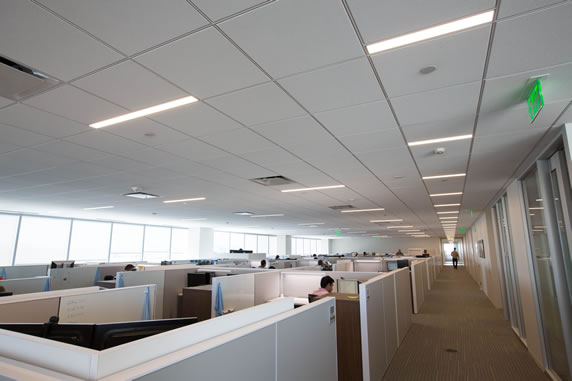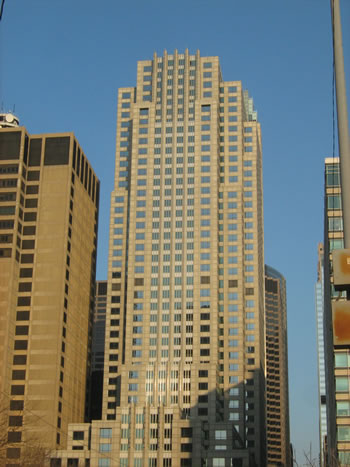
LPL Financial’s goal is to operate their new 13-floor San Diego office tower using an amount of energy equal to the amount of renewable energy created on-site.
Providing energy efficiency and cutting-edge design, LED ambient and task lighting are increasingly being incorporated into high-rise buildings – from the boardroom to the break room. Lighting is one of the largest energy users within a typical commercial high-rise, and LEDs offer superb efficiency and control while enhancing aesthetics.
In an era where energy conservation and improved efficiency have become part of our vernacular, lighting design has evolved – both in terms of use and placement of lamps, and also with the fixtures themselves.
You no longer have to compromise efficiency for beauty when it comes to using LEDs in office environments. In fact, lighting designers and high-rise commercial property owners and managers have more options than ever that combine the latest LED technology with stylish design.
LEDs to Save Energy
In Chicago’s West Loop, a sleek, energy-efficient LED design was incorporated at 500 West Monroe (the Heller International Building). As part of major renovations on a dozen floors, the building’s conference rooms now feature LED luminaires that are integrated with an innovative ceiling system that gives the space a contemporary look by using long, narrow bands of light.
Chicago’s 500 West Monroe’s conference rooms now feature LED luminaires that are integrated with an innovative ceiling system that gives the space a contemporary look by using long, narrow bands of light.
LED fixtures were integrated with a ceiling system that transforms visual distractions (lighting, air vents, etc.) into design elements by concentrating them on narrow 4-, 6-, and 12-inch channels. The lighting system also incorporates dimming and other controls.
Additional LEDs were incorporated throughout 500 West Monroe, including suspended luminaires and recessed troffers. Paired with lighting controls, these LEDs provide a low-maintenance solution that maximizes savings. LED lighting fixtures have a significantly longer life than fluorescent options (which were originally considered for the 500 West Monroe project), and also offer a lifespan of up to 50 times greater than traditional incandescent lighting.
The LED lighting used at 500 West Monroe provides more than $55,000 in annual energy cost savings as compared to the traditional lighting systems – including T8 and T12 linear fluorescent lamps – that were used in the building before renovations began.

As part of a major renovation at 500 West Monroe in Chicago’s West Loop, LED lighting was installed, resulting in more than $55,000 in annual energy cost savings as compared to traditional lighting.
LEDs to Achieve Net Zero Energy
In San Diego, architects for LPL Financial’s new 13-floor office tower were inspired to help the building achieve zero net energy. The goal was to operate the building using an amount of energy equal to the amount of renewable energy created on the site.
Four strategies drove the project: energy efficiency, employee health and wellness, connectivity, and flexibility. As plans progressed, space priorities included the incorporation of an efficient lighting system that felt comfortable to occupants, allowed for savings through dimming and daylight harvesting, and could easily accommodate the changing needs of a growing business.
LPL Financial had already invested in fuel cells for a consistent source of clean electricity, as well as an underfloor air distribution system to reduce loads on the HVAC system. Architects were looking for similarly energy-conscious lighting strategy to help the building meets its goal of net zero energy.
“We went in assuming we couldn’t afford LED lighting within the project scope, and we were hesitant to trust the technology in an interior space,” says Otto Orr, vice president of project management, corporate real estate, LPL Financial. “We’d seen a lot of advancements with LEDs in exterior and commercial areas, but hadn’t come across counterparts doing it in a classic office setting.”
Architectural drawings were analyzed, and a new lighting scheme was developed to convert fluorescent fixtures to LEDs. The new lighting design also eliminated a number of fixtures required in the original plans; total fixture count was reduced by nearly 40 percent. Almost all of the building is illuminated with LED lighting fixtures that incorporate occupancy sensors, dimming, and daylight harvesting capabilities for optimal savings.
Expert Advice
Did you know that additional energy efficiency and cost savings for high-rises can be obtained through building automation systems that include HVAC? Improved integration of lighting and HVAC controls allows facilities professionals to manage and control the two biggest energy costs for commercial buildings from a central platform, which can provide closely coordinated, automatic adjustments throughout the day to help combat costs and track energy usage.
Dave Kaminski
Dave Kaminski is the commercial office manager for GE Lighting in Cleveland.

